 Multiple Choice Questions
Multiple Choice QuestionsFocal length of a lens is +10 cm and its refractive index is 1.4, it is dipped in a liquid of refractive index 1.6, then its focal length becomes
- 16 cm
+ 32 cm
+ 16 cm
- 32 cm
If focal length of convex lens is 9 cm and that of a concave lens is -18 cm, then focal length of combination is
+ 9 cm
- 18 cm
- 9 cm
+ 18 cm
Two mirror are put at an angle of 60°C, then number of image of an object placed between the mirrors is
3
4
5
6
A convex lens makes a real image of 4 cm long on a screen when the lens is shifted to a new position without disturbing the object or the screen, we get a real image on the screen, which is 16 cm long, then the length of the object is
3/4 cm
8 cm
20 cm
2 cm
An astronomical telescope has an objective of focal length 100 cm and magnifying power of the distance between the two lenses in normal adjustment will be
106 cm
102 cm
92 cm
78 cm
Which of the following is not correct regarding the radio telescope?
It cannot work at night
It can detect a very faint radio signal
It can be operated even in cloudly weather
It is much cheaper than optical telescope
The distance between two point objects P and Q is 32 cm. A convex lens of focal length 15 cm is placed between them, so that the images of both the objects are formed at the same place. The distance of P from the lens could be
20 cm
12 cm
18 cm
28 cm
The radii of curvature of the two surfaces of a lens are 20 cm and 30 cm and the repeative index of the material of the lens is 1.5. If the lens is concave-convex, then the focal length of the lens is
24 cm
10 cm
15 cm
120 cm
A tank is filled with water to a height of 12.4 cm. The apparent depth of a needle lying at the bottom of the tank is measured by a microscope to be 9.3 cm. If water is replaced by a liquid of refractive index 1.6 upto the same height, by what distance would the microscope have to be moved to focus on the needle again
4 cm
3 cm
2.18 cm
1.55 cm
A ray of light falls on a transparent right-angled isosceles prism made from a glass of refractive index . The incident ray falls normally on one of the equal sides of this prism. The ray will suffer
total internal reflection
Interference
refraction with angle of refraction 90°
None of the above
C.
refraction with angle of refraction 90°
Let the critical angle for air glass pair of media is given by c.
Therefore, µ =
By geometry, angle of incidence at hypotenuse surface of transparent right-angled isosceles prism is 45°
Therefore, i = c = 45°
Thus, total internal reflection doesn't occur as i is not > c. And, angle of refraction is 90°.

